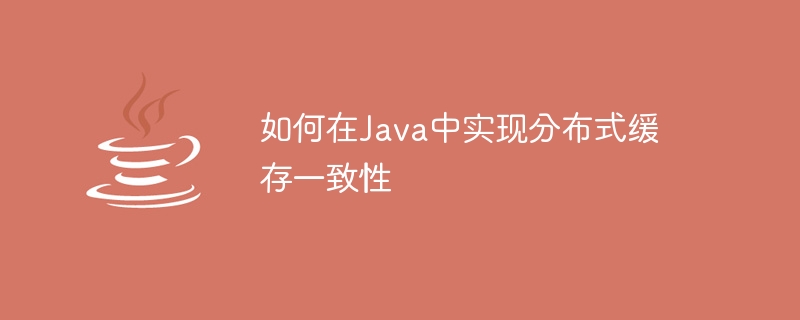Home >Java >javaTutorial >How to implement distributed cache consistency in Java
How to implement distributed cache consistency in Java
- 王林Original
- 2023-10-08 14:17:061257browse

How to achieve distributed cache consistency in Java
Introduction:
In distributed systems, caching is one of the important ways to improve system performance. However, the implementation of distributed cache is not simple due to issues related to data consistency. This article will introduce how to implement distributed cache consistency in Java and provide specific code examples.
1. The concept of distributed cache consistency
Distributed cache consistency means that in a distributed cache system, the data between all cache nodes is consistent. In other words, no matter which cache node the user performs read and write operations, they can obtain the same results.
2. Ways to achieve distributed cache consistency
There are many ways to achieve distributed cache consistency. Two common ways are introduced below.
- Cache consistency protocol
The cache consistency protocol is mainly divided into two types: strong consistency and weak consistency. Strong consistency means that data updates between cache nodes are performed synchronously, ensuring that the data of all nodes is consistent; weak consistency means that data updates between cache nodes are performed asynchronously, and data inconsistency may exist for a period of time.
In Java, ZooKeeper can be used to implement the cache consistency protocol. ZooKeeper is a distributed coordination service that can be used to achieve consistency in distributed applications.
The following is a sample code that uses ZooKeeper to achieve cache consistency:
public class DistributedCache {
private ZooKeeper zooKeeper;
public DistributedCache(String address) throws IOException {
zooKeeper = new ZooKeeper(address, 5000, null);
}
public void put(String key, String value) throws KeeperException, InterruptedException {
byte[] data = value.getBytes();
zooKeeper.setData("/cache/" + key, data, -1);
}
public String get(String key) throws KeeperException, InterruptedException {
byte[] data = zooKeeper.getData("/cache/" + key, null, null);
return new String(data);
}
}- Cache update notification mechanism
The cache update notification mechanism refers to when the data of the cache node changes , automatically notify other nodes to update data.
In Java, message queue can be used to implement the cache update notification mechanism. The message queue can push messages to subscribers. After the subscribers receive the messages, they update the corresponding cached data.
The following is a sample code that uses RabbitMQ to implement cache update notification:
public class CacheUpdater {
private Connection connection;
private Channel channel;
public CacheUpdater(String host, int port, String username, String password) throws IOException, TimeoutException {
ConnectionFactory factory = new ConnectionFactory();
factory.setHost(host);
factory.setPort(port);
factory.setUsername(username);
factory.setPassword(password);
connection = factory.newConnection();
channel = connection.createChannel();
channel.queueDeclare("cache.update", false, false, false, null);
}
public void updateCache(String key, String value) throws IOException {
String message = key + ":" + value;
channel.basicPublish("", "cache.update", null, message.getBytes());
}
}3. Summary
This article introduces two ways to achieve distributed cache consistency in Java: caching Coherence protocol and cache update notification mechanism. Both methods can achieve distributed cache consistency, and the specific choice should be judged based on the actual situation. In actual development, you can choose a suitable solution according to your needs to achieve distributed cache consistency.
The above is the detailed content of How to implement distributed cache consistency in Java. For more information, please follow other related articles on the PHP Chinese website!
Related articles
See more- How to clear PS cache?
- The core of hadoop is the distributed file system hdfs and what?
- How to clear app cache on mobile phone
- MySql and distributed transactions: how to deal with the consistency of distributed data
- Go Language Developer Guide: How to use consistent hashing to achieve cache load balancing.

